Effect of community participation on knowledge, attitude and practice of domestic solid waste management in Uyo, Nigeria
Edward E1, Ofili AN2
Abstract
Background: The increasing burden of solid waste generated in many parts of the developing world is a cause for concern as it impacts on the environment and the health of the population. Community participation as an intervention can become a veritable opportunity for individuals and communities to address this challenge.
Aim: The study aimed to assess the effect of community participation on the knowledge, attitude and practice of house-heads in peri-urban communities in Uyo, Akwa Ibom state.
Materials and methods: The study was set at peri-urban communities in Uyo, Akwa Ibom state and employs a quasi-experimental design. A multistage sampling method was used to sample household heads for the study. A pretested interviewer administered semi-structured questionnaire was used to get the opinions of the household heads before and after the intervention. Community participation, as an intervention involved distribution of waste bags and education of community members about the need for proper management of wastes. A committee was set up to ensure proper management of domestic waste in the community. A scoring system was used to assess and compare the level of knowledge, attitude and practice of domestic solid waste in both communities. The level of significance was set at <0.05.
Results: A total of 246 (98.0) respondents in the intervention arm and 250(99.6) in the control arm participated in the study. The mean ages of participants in the intervention and control groups were 45.84±14.4 years and 45.31±14.4 years respectively. Most of the respondents in the intervention and control groups were male. At post-intervention, there was an improvement in the level of knowledge, attitude and practice in the intervention group, which was in all cases statistically significant.
Conclusion: Community participation can play a critical role in improving solid waste management in communities.
Keywords: Community participation, peri-urban communities, knowledge, attitude, practice.
Introduction
Waste generally refers to all unwanted and economically unusable materials that result from human activities, discarded purposefully or accidentally into the environment.1,2 The term ‘solid wastes’, includes garbage (food waste), rubbish (paper, plastics, wood, metal, throw away plastic containers), demolition products (bricks, masonry, pipes), sewage treatment residue (sludge and solids from coarse screening of domestic waste), dead animals, manure and other discarded materials.3 Domestic or household level solid waste, therefore, includes ordinary refuse, garbage, swill, rubbish and all forms of refuse from household activities.4,5 Domestic solid waste contributes largely to the amount of solid waste generated daily6 and hence it is of great concern to individuals and the entire community, how this waste is disposed of. Community participation opens up opportunities for communities to be actively involved in decision making and policy development. The communities take more proactive steps in ensuring that individuals are aware of the health risks and problems of disposing of their domestic solid waste in a disorderly fashion. The community can effectively mobilize its resources by taking responsibility for environmental cleanliness and collection of waste disposal fees.7
Globally, the volume of municipal waste has increased to about 1.3 billion tonnes of solid waste per year and this volume is expected to increase to 4.3 billion tonnes per year in 2025 representing an increase from 1.2 to 1.42kg per person per day.2 The United Nations conference on environment and development at Rio de Janeiro also known as Rio 1992 drew attention to this possible increase urging member countries to take more pragmatic steps to minimize wastes produced, maximize environmentally sound waste reuse and recycling strategies, promote environmentally sound waste disposal, and extend waste service coverage. With increasing urbanization, consumption rates of food and other resources have increased with resultant production of waste both at the municipal and household level. Some studies have tried to quantify the solid waste generation in Nigeria.8-11
Community participation has been defined as a process whereby individuals, groups and organizations engage in planned action to influence social problems.12 The sustainability of projects undertaken by government or corporate groups hinges on the acceptance of those project by the local community and the level of their involvement from the conceptual phase to the time the project is executed.13 Many community dwellers appear not to be concerned with how refuse and garbage are disposed in their vicinity.14 The current traditional approach in which the waste management agency and local governments provide structures and processes for solid waste management is weak, and unsustainable due to poor coverage and non-implementation of policies that are already in existence.11
This study seeks to assess and compare the effect of community participation on knowledge, attitude and practice of domestic solid waste management among household heads in peri-urban communities in Uyo, Akwa Ibom State, Nigeria.
Materials and methods
Study Area: The study was conducted in Uyo, the capital city of Akwa Ibom State located in the southern part of Nigeria, within longitude 7° 54" and 8°00" East of the Greenwich and 4° 59" and 5° 14" North of the Equator. It is bounded to the north by Ibiono, Ikono, and parts of Uruan. It is bounded to the south by Etinan, Nsit Ibom and Ibesikpo Asutan. Uyo shares boundaries to the East and West with Uruan and Abak respectively. Uyo, as used in this study, is Uyo Capital City, which extends to some of these boundary communities.
Study design: The study design is a quasi-experimental study with control, conducted in three phases, pre-intervention, intervention and post-intervention.
Study population: The study population consisted of households from both the control and intervention communities. For the purpose of this study, “household” is defined as a group of individuals that eat from one pot.3 A residential house that can have more than one household.16 The study was intended to get responses from consenting household heads or consenting adult members of their households who generate domestic solid waste and live in the control or intervention area. The inclusion criteria for this study were participants residing in peri-urban areas located in Uyo Capital City. Respondents were consenting household heads or adult members of the household who had resided in the community for at least 6 months. Those excluded from the study resided near large markets and industrial corporations that may influence the outcome of the study and those living in communities experiencing communal disharmony. Respondents that were deemed mentally unstable were exclude from the study.
Sample size estimation: Sample size estimation for comparing two proportions was used.17 This gave a sample size of 251 per arm and includes an anticipated non-response rate of 10% and a design effect of 2. The power of the study was put at 80%.
Sampling technique: A multistage sampling technique was used to select households for the study. Uyo has already been stratified into 8 sectors or neighborhoods in the Uyo City development plan.16 The intervention and control groups were chosen for groups A and B using simple balloting. Using simple random sampling, the first community picked was from the intervention group-Ikot Nteun Nsit, while the control community picked was Ikot Ekpe. The distance between the two communities was over 15km.
The communities were divided into enumeration areas (EA). Each enumeration area served as a cluster. A simple random sampling method was used to select clusters from the list of enumeration areas. Four clusters were selected in each of the study and control communities using simple random sampling. A central place in each area was chosen and an empty bottle was rotated on the ground. When it ceased to move, the direction of the neck of the bottle was taken as the starting point. Responses were gotten from each residential house. In residential houses with more than one household, simple random sampling was used to select the household for the study. This was done until the sample size of 251 per group was obtained.
Data collection: Data collection was carried out using two trained research assistants. A pre-tested semi-structured interviewer administered questionnaire adapted from findings in literature was employed for this study. The questionnaire had five sections and covered information on respondents’ socio-demographic characteristics, knowledge of domestic solid waste management, attitude towards domestic solid waste management and the practice of domestic solid waste management. The same questionnaire was used at pre and post intervention.
Intervention: Community participation, as an intervention in this study involved distribution of waste bags from house to house in the intervention arm of the study and education of community members about the need for proper management of wastes using information, education and communication materials. A committee was set up to ensure proper management of domestic waste in the community and community members offered ideas and strategies that could be used to mitigate waste challenges in the community. Community resources like the use of village announcers were intermittently used to warn erring community members of a fine if they disposed of their waste in the wrong places. This was also reinforced in their religious gatherings. This intervention lasted for about 4 months.
Data management: Completed and returned questionnaires were documented and inspected daily to detect correctness and minimize errors. Questionnaires were manually sorted out, serially numbered and coded before entry into the computer for statistical analysis using SPSS version 25. Data analysis was done using descriptive statistics (frequency, proportions, median, means and standard deviation) to summarize quantitative variables. A grading system was used to assess knowledge, attitude, and practice of domestic waste disposal and was graded as very good, good and poor. There were 15 questions that assessed knowledge, 9 questions that assessed attitude and 6 questions that assessed practice. A score of one mark was given for every correct statement by the respondents. Respondents that said they did not know were assumed to have no knowledge of the question and were not awarded any mark. The category of scores for knowledge were from 22-27, 12-21 and 0-11. The category of scores for attitude were from 6-9, 4-5, and 0-3, while the category of scores for practice were 6-7, 4-5, and 0-3. The categories were each graded as very good, good and poor respectively for knowledge, attitude and practice of domestic solid waste management. Bivariate statistical tests like chi-square, Student T test and Mann Whitney U test were used to determine the association between variables as appropriate at 5% level of significance.
Ethical consideration: Ethical approval was obtained from the Research Ethics Committee of the University of Uyo Teaching Hospital, Uyo, Akwa Ibom State and the Akwa Ibom State Health Ethics Committees. Permission to undertake the study was also sought from the Uyo and Nsit Ibium Local Government Council offices. Informed consent was sought from the heads of the communities in which the research was carried out. The community leaders were informed of the purpose of the research and its importance to their community and the larger society as a whole. At the end of the study, the control group was administered the intervention given to the study arm.
Results
Table 1: Characteristics of household heads at baseline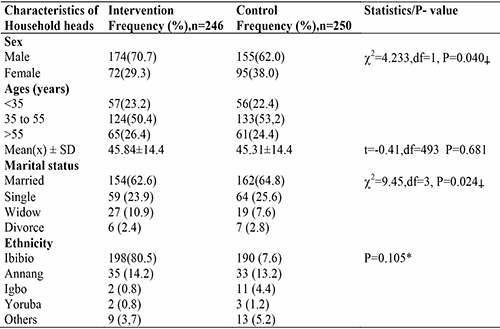
Table 2: characteristics of household heads at baseline continued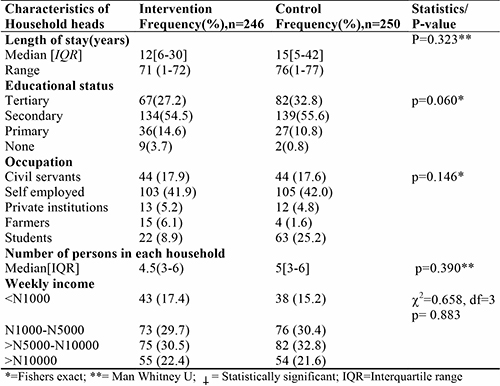
Table 3: Comparison of proportion of study subjects with poor, good and very good knowledge of domestic solid waste management
Table 4: Mean Knowledge score, statistical comparison and proportion of change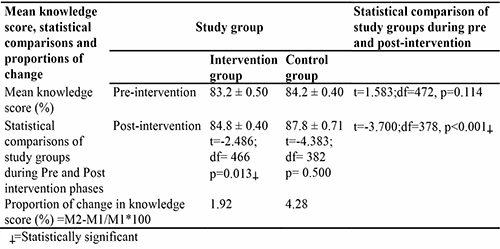
Table 5: Comparison of proportion of study groups with poor, good and very good attitude of domestic solid waste management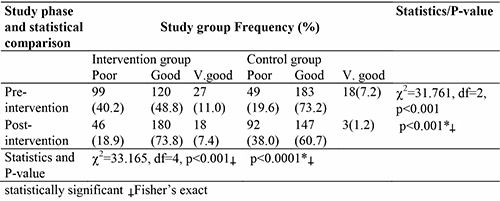
Table 6: Mean attitude scores, statistical comparisons and proportion of change in attitude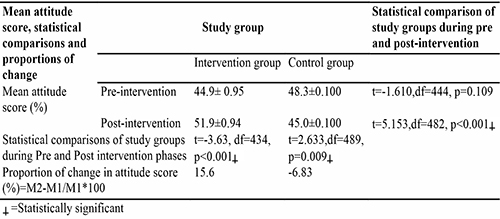
Table 7: Comparison of proportions of Intervention and control groups with poor, good and very good practice of domestic solid waste management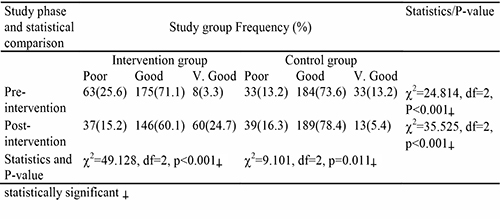
Table 8: Mean practice score, statistical comparisons and proportion of change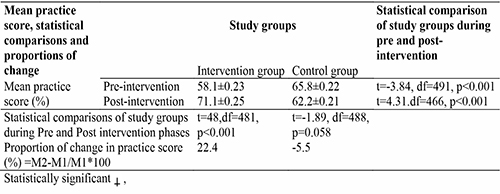
The number of household heads that participated in the intervention group before the intervention was 246 (98.0%) while 250 (99.6%) participated in the control group. During the post-intervention phase, 243 (96.8%) household heads participated in the intervention group, while 241(96.0%) participated in the control group. Tables 1 and 2 display the characteristics of the household heads in the intervention and control communities. The mean age of the respondents in the intervention and control groups were 45.85+14.4 years and 45.31+14.4 years respectively and this observed difference was not statistically significant (p=0.681). The median length of stay of household heads in each group were 12 years and 15 years respectively and the length of stay of respondents in both communities were comparable, p=0.323. Most of the respondents have had secondary school education in the intervention (54.5%) and in the control arm (55.6%). Both communities are comparable (p=0.060). Table 3 shows the proportion of respondents who had poor, good and very good grades in knowledge both intervention and control groups. There was an increase in the proportion of respondents that had very good grades in both the intervention and the control communities. At baseline, the grades in both groups were comparable, p=0.300, however at the post intervention phase, there was a statistically significant difference in the grades of household heads in the intervention and control groups p<0.001. Table 4 shows the knowledge scores of respondents in the intervention and control groups pre and post-intervention. There were no statistically significant differences between both groups at baseline, p=0.114, however after the intervention, there was a statistically significant difference between knowledge scores of both groups, p<0.001. Table 5 displays the comparison of proportion of study groups with poor, good and very good attitude of domestic solid waste management. At baseline, the comparison of the grades of the intervention and the control community were statistically significant, p=0.001; after the intervention, the grades of both groups were statistically significant, p<0.001. Table 6 displays the mean attitude scores, statistical comparisons and proportion of change in attitude of the intervention and control groups. At baseline, there was no statistically significant difference between the intervention and the control groups, p=0.109, however after the intervention, there was statistically significant difference between the intervention and the control group, p<0.001. There was a 15.6% change in the attitude of the intervention groups after the intervention. Table 7 displays the comparison of proportions of the intervention and control groups with poor, good and very good grades of practice of domestic solid waste management. There was a statistically significant difference in the intervention groups before and after the intervention, p<0.001. There was also statistically significant difference in the control groups pre and post-intervention, p=0.011. Table 8 displays the scores on the practice of solid waste management of respondents in both groups. There was a 22.4% increase in the scores of respondents in the intervention group at post-intervention. Conversely, there was a -5.5% decrease in the scores of respondents in the control group. There was no statistically significant difference in the scores of the control groups, p=0.058, while there was a statistically significant difference in the intervention group, p<0.001.
Discussion
The study enrolled household heads from communities that shared similar demographic characteristics. The mean age of the intervention and control groups were 45.88± 14.4 years and 45.46 ± 14.4 years respectively. This mean age was slightly higher than a study done in Sokoto where the mean age was 43.8 years for the intervention and 45.1 years for the control.18 The majority of the household heads were males reflecting the typical male dominance observed in many households in Nigeria and indeed sub-Saharan Africa. A large number of respondents in both intervention and control groups are married, 154 (62.6%) and 162 (64.8%) respectively. This agrees with findings of another study in Onitsha.15 The median length of stay in the intervention and control were 12 [6-30] years and 15[5-42] years respectively. Secondary school education was the highest level of education attained by a little above half of respondents in both intervention and control groups. This was higher than findings in a similar study in Onitsha where 40.2% of the respondents had attained secondary school education. This is in conformity with the National Bureau for Statistics report that with rising secondary school education, the literacy levels of males and females in the country were relatively high.19 This suggests that respondents were enlightened enough to participate in the study.
The study assessed the knowledge of respondents about domestic solid waste management and related health and environmental challenges. Findings from this study showed that at baseline, in both the intervention and control communities, many respondents were able to relate the occurrence of certain disease conditions with poor solid waste management. This showed that respondents in both groups were knowledgeable about the importance of solid waste management of household waste. This was in agreement with previous studies that reported high level of knowledge among participants of their study.1,18 Following the intervention, there was a statistically significant increase in the level of knowledge scores in the intervention group and the control group, and in both instances, it was statistically significant. The high level of knowledge in this study was a little higher than the results from a study in Sokoto state where the baseline scores for knowledge of respondents were 77.8%±15.0 and 78% ±18.4 respectively for intervention and control communities.18 The current efforts of government and other partners at increasing community awareness about the problems of poor solid waste management, alongside the intervention in this study may have contributed to the increase in the level of knowledge.
The study assessed the attitude of respondents at baseline to domestic solid waste management in both the intervention and control groups and changes in their attitude after the intervention. The mean attitude scores in both the intervention and control groups at baseline were comparable in both communities. The study showed that after the intervention, there was a statistically significantly improved attitude of household heads in the intervention arm of the intervention group. The proportional change in attitude after the intervention was 15.6% which significantly higher than what was observed in the control arm. This stresses the importance of the intervention as it resulted in behavioural and attitudinal change. The poor change in attitude recorded in the control arm may explain the reason why open dumping of waste is very prevalent in many communities in Nigeria, even though they have good knowledge of how to manage waste and the consequences of poor waste management.4,6
The study assessed the practice of solid waste management in the intervention and control group. The study demonstrated the effect of community participation on the practice of solid waste management among household heads in the intervention group. In the various constructs under practice, there was a statistically significant increase in the proportion of correct responses to the questions asked in the intervention arm after the intervention. It is obvious that although the level of knowledge of solid waste management was very high in the control group, it did not translate to very good practice. This supports findings in similar some study.18 In some studies consulted, several practices of solid waste management like waste sorting, reuse and recycling of waste were low.6 Community participation as a means to an end can help to strengthen waste management practices at community level through the full engagement of members of the community in activities of solid waste management in the face of already high knowledge within peri-urban communities.10 This study provides policy direction and focus to the waste management agency on the need to build on knowledge already existing in communities to utilize more pragmatic methods native to the communities to improve their attitudes and towards the management of domestic wastes generated. This study is not without its own limitations as it focuses on peri-urban communities in Uyo, Akwa Ibom State. The problem of waste management, however, transcends to urban and municipal areas. It is however hoped that the intervention employed here can be applied to some urban areas in the state and country and help to complement government efforts at municipal waste management. The study is also limited by the fact that it only considers solid waste from households in residential houses. Domestic solid waste can also be generated in non-residential units like shops and religious institutions. It is hoped that with the intervention in place, the attitude and practice of proper solid waste disposal will be scaled up to the entire community.
Conclusion
In this study, community participation was utilised as a means to improve the knowledge, attitude and practice of household heads residing in a peri-urban community in Uyo, Akwa Ibom State. The study showed that although knowledge of respondents about domestic solid waste management and related health and environmental challenges was high in both communities, the attitude of respondents required improvement, which was brought about by the intervention. The practice of domestic solid waste management in the intervention arm of the study was significantly improved upon by the intervention employed, which was community participation. Peri-urban communities in the country can employ this sustainable intervention to coordinate waste management in their areas without waiting for government intervention.
References
- Momoh JJ, Oladebeye DH. Assessment of awareness, attitude and willingness of people to participate in household solid waste recycling programme in Ado-Ekiti. J Appl Sci Environ Sanit. 2010;5(1):93-105.
- Taiwo AA. Waste management towards sustainable development in Nigeria: A case study of Lagos State. Popul (English Ed). 2009 ;4:173-179.
- Parks K. Environment and Health. In: Preventive and Social Medicine. 21st ed. Banarsidas Bhanot. 2011:695-697.
- Kamara AJ. Household participation in domestic waste disposal and recycling in the Tshwane Metropolitan Area : an environmental education perspective. 2006; Available online at http://uir.unisa.ac.za/handle/10500/1460. Accessed on 23 October,2017.
- Roche N. Environmental health. In: Short Textbook of Public Health Medicine for the Tropics. 4th Editio. Georgina Bentliff. 2003:337-338
- Yoada RM, Chirawurah D, Adongo PB. Domestic waste disposal practice and perceptions of private sector waste management in urban Accra. BMC Public Health. 2014;14(1):697.
- Muller M, Hoffman L. Community partnerships in integrated sustainable waste management: Tools for Decision-Makers; 2001. In: Experiences from urban waste expertise program (1999-2001). Available online from https://www.irewash.org/resources/community-partnerships-integrated-sustainable-wastemanagement. Accessed on 20 December,2016.
- Amori AA, Fatile BO, Ihuoma SO, Omoregbee H. Waste generation and management practices in residential areas of Nigerian tertiary institutions. J Educ Soc Res. 2013:45-52.
- Ogwueleka T. Municipal solid waste characteristics and management in Nigeria. J Environ Heal Sci Eng. 2009;6(3):173-180.
- Akwa Ibom State Environmental Protection and Waste Management Agency. Akwa Ibom, the emerging model clean state: yesterday, today and the future: Stake holders disalogue 2019, Uyo.
- Ukpong IE, Udofia EP. Domestic solid waste management in a rapidly growing Nigerian city of Uyo. J Hum Ecol. 2011;36(3):229-235.
- Holt CM, Fawcett SB, Schultz, JA, Berkowitz B, Wolff TJ, Francisco VT. Building Community Practice Competencies Globally through the Community Tool Box. Global Journal of Community Psychology Practice,2013; 4(4):1-8
- Ltumbesi SL. Influence of community participation on community ownership of donor funded projects: A Case of Saidia, Samburu County, Kenya. Humanit Soc Sci. 2015;3(5):193-196.
- Ebong RD. Appraisal of knowledge and attitude of Akwa Ibomites toward a sustainable environment in Nigeria. Environ Health Perspect. 2002;110(3):211-212.
- Emelumadu OF, Azubike OC, Nnebue CC, Fazubike N. Practice, pattern and challenges of solid waste management in Onitsha metropolis, Nigeria. American Journal of Public health research. 2016;4(1):16-22.
- Emmanuel E. Housing satisfaction attributes among households In Uyo Capital City Territory, Akwa Ibom State, Nigeria. 2015, Ph.D thesis from department of urban and regional planning faculty of Environmental studies, University of Nigeria, Enugu campus, 2015. 145-250.
- Varkevvisser CM, Pathmanathan I BA. Designing and conducting health systems research projects. Ottawa, Canada: International development research center. 1991;210-216.
- Abiola AO, Ibrahim MTO, Usman BB, Sabitu KS, Abubakar IS, Alausa OK, et al. Domestic refuse management practice in Sokoto: effect of health education. The Nigerian Postgraduate Medical Journal. 2010;17(3):210-217.
- Mamady K. Factors influencing attitude, safety behaviour and knowledge regarding household waste management in Guinea: A cross sectional study. Journal of environmental and public health. 2016; 93-100.